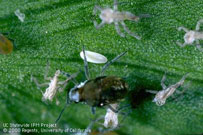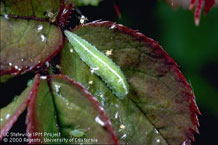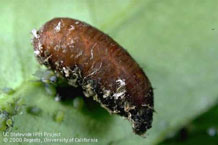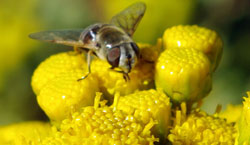home | fall garden | rock garden
Syrphid Fly
With over 6,000 species of syrphid flies, they are common throughout the world and can be found on all continents except Antarctica. They are sometimes called hoverflies or flower flies because as adults they are found hovering over flowers. Syrphid flies mimic the look of honey bees and wasps, which serves to ward off their predators. In order to tell the difference you must look closely, flies have two wings and bees have four. Also, flies have stubby antennae and the antennae of bees are long and slender. The size of an adult syrphid fly varies, depending on the species. Some are small and thin and others are large and hairy. Syrphid flies are brightly colored with spots, stripes and bands of yellow and brown covering their body. Females lay their whitish to gray, oblong eggs near aphids or within aphid colonies. Larvae are legless, maggot-shaped, and vary in color and patterning. There are two types of syrphid fly larvae. Some species eat decaying plant or animal matter, whereas most other species eat aphids, thrips, and other plant-sucking insects. As adults, their principal food is nectar and pollen. Because many species of syrphid fly larvae prey upon pest insects, they are seen as a natural means of reducing levels of pests.
 |
 |
 |
 |
 |
